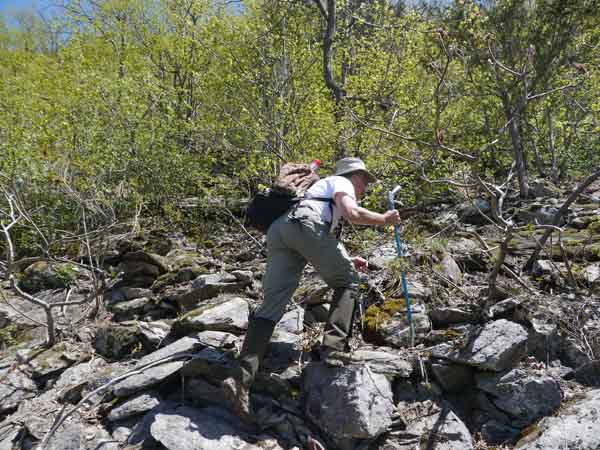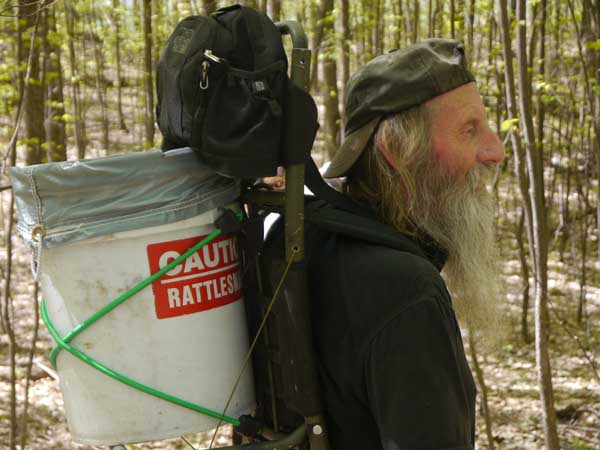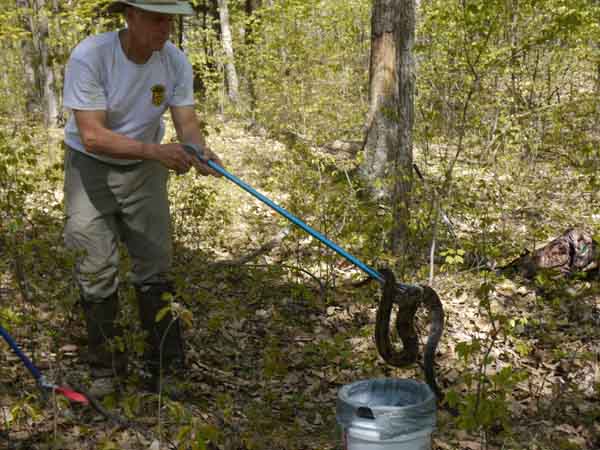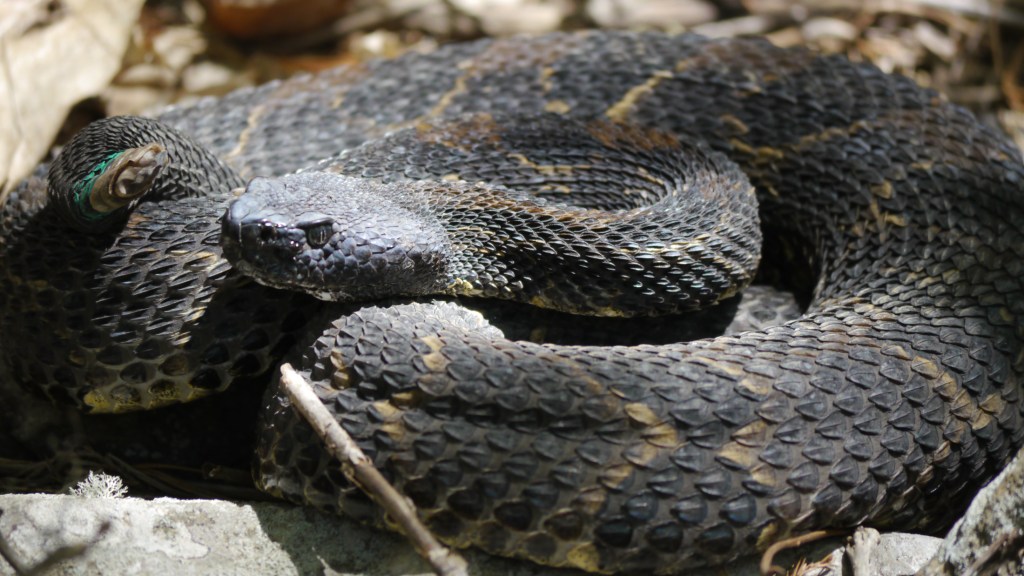Doug Blodgett, a biologist with the Vermont Fish and Wildlife Department, held the radio to his ear, listening intently to the persistent beeps. “Watch your step, fellas,” he says. “He’s close. Real close.”
“He” is a large timber rattlesnake that we’ve been radio tracking this afternoon as part of a Vermont research partnership between The Nature Conservancy, the Vermont Fish & Wildlife Department and the Orianne Society. Telemetry had gotten us within a few yards of the snake. But the rattler remained hidden amongst the leaf litter, rocky outcroppings and fallen limbs.
I didn’t need to be told to watch my step. Over the past two days, I’ve had plenty of hair-raising excitement: scrambling up and down steep cliffs, grasping at crevasses and climbing trees, all the while keeping an eye out for rattlesnakes under foot.
We had donned snake chaps — sturdy leggings that a snake’s fangs couldn’t penetrate — and received stern safety warnings from Blodgett. We were given careful instructions on what to do in case of emergency. It was hard not to watch your step. Every step.
But this wasn’t just an adrenalin-filled outing. The research here is helping conservationists learn the movements, genetics and health of timber rattlesnakes at the northernmost part of their range, in the Appalachian Mountains of Vermont.
“Timber rattlesnakes are almost mythical creatures for many people,” says Dr. Christopher Jenkins, executive director of the Orianne Society, a foundation devoted to conserving snakes and other reptiles. “They inspire strong passions in people, ranging from fear to awe. And people have all kinds of ideas about snakes. But we wanted to study them to find out where they go and what they do.”
Timber rattlesnakes are listed as endangered in Vermont, and have not fared well across much of their range. For years, this was due in no small part to human persecution; people killed snakes relentlessly whenever they could. In fact, Vermont paid a bounty on dead rattlers until 1981. Today, more people value them as a large predator, as a symbol of wildness and as a part of the northern forest.
“Watch Where You Put Your Hands”

Still, even for those of us who appreciate snakes, poking around their dens can cause some anxiety. As we approached our first snake — almost perfectly camouflaged on a rock ledge, the same kinds of rock ledges I had been using to steady myself for the past hour —I felt a mix of fascination, excitement and gut-level fear.
Minutes later, we scrambled up a mix of rocky scree and vertical cliff faces. “Watch where you put your hands,” said Blodgett. “The snakes could be out anywhere.”
And so I found myself continually faced with a choice: grasp a rock that very well could have a snake attached to it, or tumble down a rocky escarpment. Hmmm…
But the fact is, there are very few places left in Vermont where you might realistically encounter a rattlesnake. Jim Wilson, a serious amateur herpetologist and volunteer trained in snake capture, once visited the sites throughout the state where historic records had indicated snake dens.
“With the exception of these few sites, I found nothing,” he says. “The snakes were gone. Completely gone.”
The research program aims to understand the fate of the remaining snake population so a similar fate doesn’t befall it.

Last year, the researchers fitted rattlesnakes with radio transmitters that monitored their movements from hibernating den to summer range and back. They aimed to find travel corridors, where snakes breed, where they spend most of their time. This will help conservationists better protect the entire range of the timber rattlesnake.
Rattlesnakes den communally each winter, congregating large portions of the population in a few areas. Many of these dens are protected, but little is known about where snakes travel once they leave the dens.
“The snakes congregate in the winter so we know where they are, but once they leave their dens in the spring, we didn’t really know where they headed,” says Jenkins.
Track of the Rattlesnake

The research yielded interesting results: the rattlers had a home range of about two miles, with some traveling as far as 3.6 miles from the den site. They avoided roads, which could be a significant factor in keeping populations isolated. The snakes headed to preferred spots for basking in the sun, hunting prey and breeding.
“These animals know where they are on the landscape,” says Blodgett. “They aren’t just moving randomly. Many people don’t think of snakes as intelligent. Follow them around and you’ll think differently. Rattlesnakes know where they’re going; they know where they’ve been.”
The radio telemetry data are now helping biologists determine where snakes have been. But after capturing a full year’s worth of data, it’s time now to remove the tags. The snakes are tracked as they emerge from their dens, captured and the tags surgically removed.
“One of the goals of this project is to minimize its impacts on snakes,” says Chris Jenkins. “We wanted to get in, get the information we need and get out.”
Which is why I’ve been following researchers for the past two days. Many of the snakes had not yet emerged from the dens, as indicated by the slow, dull beeps issuing from Blodgett’s radio. But one rattler — identified on the data sheet as Snake #111– had already scaled a cliff and was headed into the uplands.
We had climbed up over the ledge and headed into the forest. The radio transmitter beeps became louder. Blodgett smiled. “These creatures jazz me up big time,” he said. “I’m never happier than when I’m out here doing this.”
Now, it seemed, the snake was somewhere right around us. My mind transformed every gnarled tree branch on the ground into a large snake. I watched where I put every step. The detail of the forest floor popped out in vivid color.
But we kept walking. No snake. “Where have you gone, Snake #111?” Blodgett muttered to himself.
He listened to his transmitter again. “We walked past him,” he said. “Or over him.”
We turned back, each step now even more intentional. And then, there he was: coiled at the base of a rock.
Three of us — all on high alert, and two experienced snake catchers — had come within a few feet of the snake and missed it.
The snake’s instinct was not first to rattle or strike, but rather to use its perfect camouflage to protect it from danger. A casual hiker in the woods would have strolled by without ever knowing she had passed within feet of a large rattlesnake.
As it sat there, I saw the snake for what it was: a beautiful creature, perfectly evolved to these mountains, this landscape. A creature that can remain a part of the Vermont forest, if their habitat can be protected: an easier task now with the information gathered from this research.
“Timber rattlesnakes have been studied a lot, but surprisingly, there wasn’t a lot of information on their movement patterns or key habitats,” says Blodgett. “We can use what we’ve learned for future conservation efforts to protect the areas that snakes are using throughout the year.”





Pretty urgent. Could you please contact me ASAP. Getting ready to do research on a number of den sites. Thanks
Have a population on my farm. Dont know much except general summer location. Rocky ravine.
Julie – Fear of snakes is not rational, it’s in our genes. http://www.boston.com/news/education/higher/articles/2008/02/29/uva_research_snake_phobia_hardwired/?page=full
Interesting information about the snakes. However, I found the sensationalized sense of fear and danger a bit disappointing. Maybe the point was to have the “redemption” at the end of the article by finding the snake quiet and non-threatening, but the inflamatory title and description of the hunt is part of all snakes’ problems. Too many people’s fears lead to snake destruction (as pointed out in the article). Again, interesting story, but I’d rather see a more responsible approach to allay the general public’s irrational fear of snakes to promote their preservation.
Nice article. Here in our corner of the Catskills, we’re not far from a wintering den, and nearly every year we encounter a few husky timber rattlers heading downhill to the streambanks. There, they can spend the summer feeding on mice, rats and chipmunks before heading back to the den in autumn. It does get too exciting sometimes, though!
Thanks Matt … great piece of writing as usual … do not go out of my way looking for rattle snakes like I do Sage Grouse though.